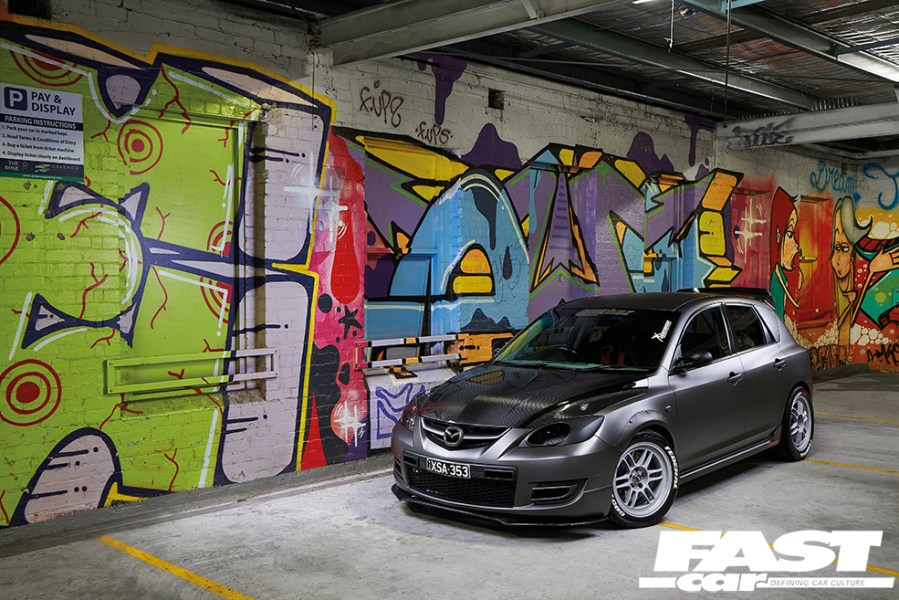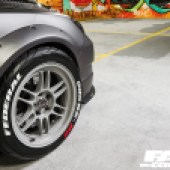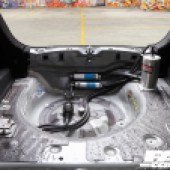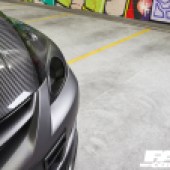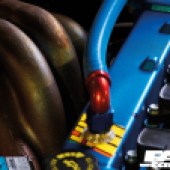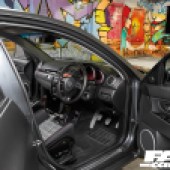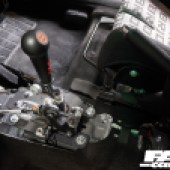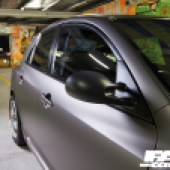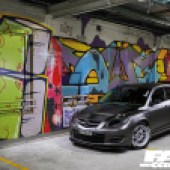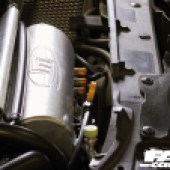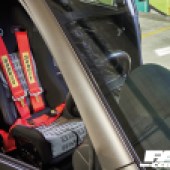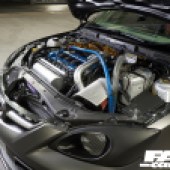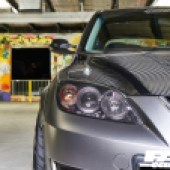This modified Mazda3 MPS is Australia’s fastest, clock a 10.8 second quarter mile. But it’s also designed to slay GT-Rs at track days… oh, and to ferry the kids to school.
Being the first to do anything is hard. You inevitably come up against more obstacles, go through more heartache and, certainly in the car world, spend more money than anyone else. But, if you can suffer through all that, you may come up with a project that is the envy of many. Such is the story of Alex Stevicic’s modified Mazda3 MPS (or MPS3 as it’s known Down Under).
Alex purchased the Mazda3 MPS new in 2008, he initially had no idea of the performance potential… until of course, he gave it a few full-throttle squirts, and realised it’s was indeed a quick motor. However, as is well-documented, he also realised the turbo tailed off by 5700rpm, which got him thinking that by simply changing a turbo, there could be an easy win to be had.
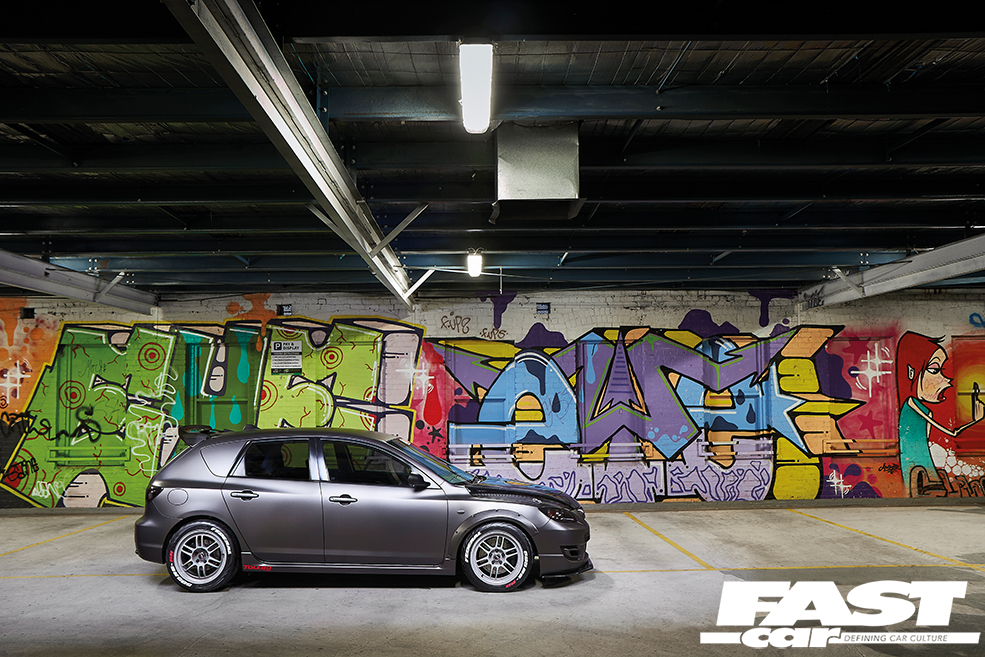
As it turns out, he was right, but getting there was an arduous task, given the near total lack of Mazda3 MPS expertise in Australia – a country famous for preferring rear or AWD sedans to FWD hatchbacks. “You couldn’t just go to a shop or go online and order your choice of aftermarket manifold, for example, because at that time, no one made them. So, to find workshops who were happy to make something was the difficult part, and a lengthy process. Every time you go custom, it’s obviously big bucks as well, because you’re not buying an $800 manifold for a Mitsubishi Evo, you’re suddenly spending 2-grand for a one-off piece. So, it made it very difficult and time consuming when I had to save all that money to do it. Again, that’s part of the problem with pioneering a new platform – you’re the one that’s paying to get all these parts made for everyone else.”
Bit by bit though, Alex managed to find the right workshops and build the car up from its fast, but stock, form into something far more potent. First came a tune, courtesy of Horsepower Factory in Dandenong, who created the first such plug-and-play solution in the country using Alex’s car as the test bed. Some two years later they developed a 50/50 E85/98 octane tune, which allowed Alex to get the most out of the stock, cam-driven direct-injection fuel pump and bump things up further. “Because of the cam-driven pump, you couldn’t run 100% E85 because it clogs up.” This power boost also meant it was finally worth finishing all the bolt-ons, such as the custom 3.5-inch mild steel exhaust, Treadstone TR1035 intercooler, JMF intake manifold and so on. A couple of years later, the engine had turned over 170,000km and was feeling a bit tired, thanks to worn rings. So Alex decided to park it, pull the engine and re-build it.
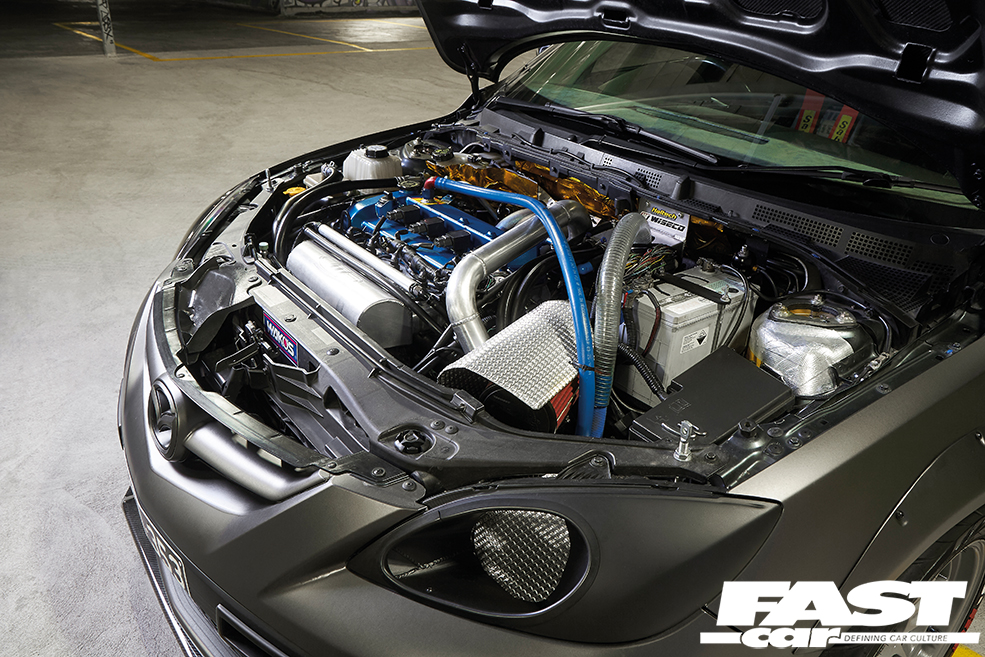
Of course, this process took longer than you might expect, too. Thanks to Alex’s very scientific way of building cars, and again, the lack of local industry knowledge about the platform, he spent the first year just talking to the most skilled people he could find, listing their ideas, and deciding exactly what to implement.
FWD stormer
The biggest issue he faced was fuelling. No aftermarket computer, even today, can run direct injection, and the stock pump, irrespective of its inability to run E85, could never supply enough fuel. The solution? Installing a complete secondary port injection system, with twin Pierburg pumps, a custom alloy swirlpot, Fuelab lines, pressure regulator and rail, and four massive Bosch 1650cc injectors. Obviously, getting this system to work wasn’t easy, but thanks to some advanced jiggery pokery, Haltech’s support in configuring their Elite 1500, and the tuning abilities of Melbourne outfit Quickbitz, it now runs flawlessly.
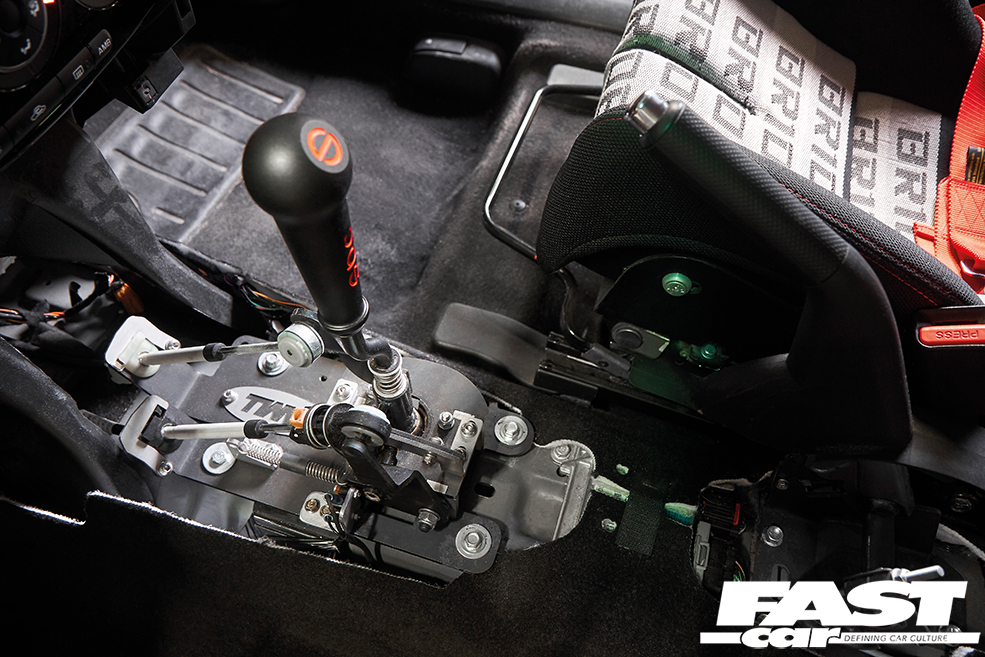
The rest of the engine and driveline work seemed to come together much more easily, but again, only thanks to the research done beforehand. JD Autoworx stripped everything down, CNC ported and polished the head before Orger Engines did the skimming, shaved the block, and balanced the Wiseco pistons and Carillo rods along with the stock crank and camshafts. Freak Fabrication did all the custom aluminium work, such as the catch cans, headlight intake, surge tank and intercooler piping, while Horsepower Factory fitted the fuel system, and added the incredibly touchy Clutchmasters 725 twin-plate clutch and flywheel. Quickbitz, as well as the tuning, handled all the wiring and installation, with many parts supplied by Edge Autosport. Phew!
Given the car wasn’t designed to be a pure drag machine, much work needed to be done to the body and chassis to make it adaptable enough to cover multiple roles. In terms of the bodywork, Jarrad Davis, the man behind JD Autoworx, discussed and worked on ideas Alex himself came up with for the wing, splitter and bonnet. Once the final plans were made, Jarek Horsch from Horsch Industries turned all these ideas into a carbon fibre reality.
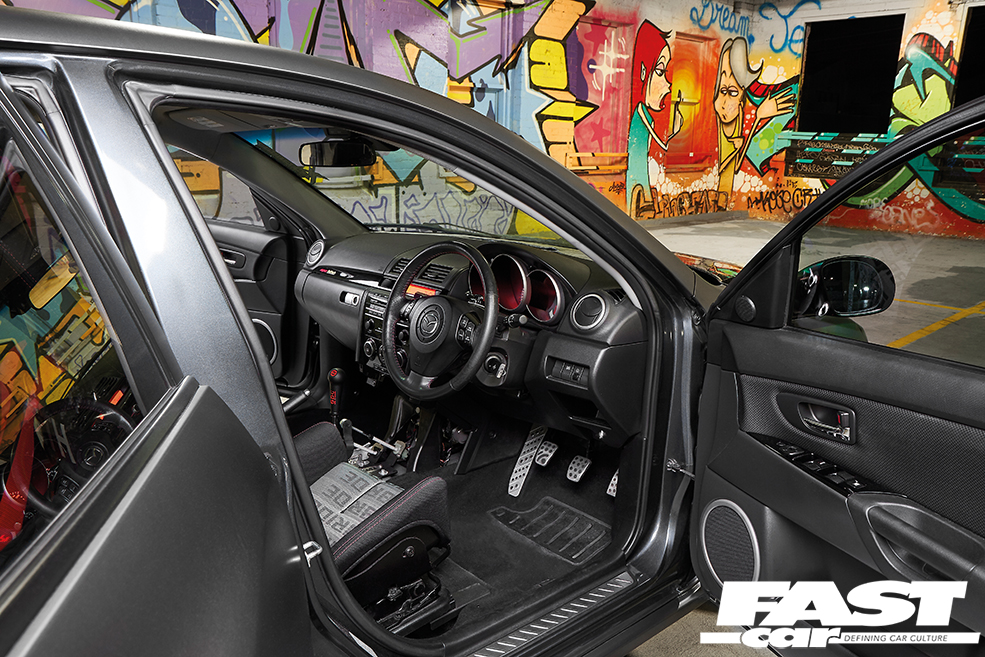
The chassis work was completed by Nick Luxman from Lux Racing. Including essential tasks like customising and fitting the Hotchkis ARBs. IThere was also the small matter of installing Moog links and rear camber arms, and fitting the AutoExe front and rear lower control arm bars. Coupled with Megan Racing front camber arms, Nolathane bushings and BC BR coilovers, it’s clearly quite the setup.
Given the car was always going to be a drag racer, the brakes were upgraded with DBA T3 slotted rotors, Hawk pads and Agip fluid at first. The wheels were downsized to 17-inch RPF1 wheels and 265/40 front and 245/40 rear Federal RS-RRs street rubber. (Mickey Thompson drag radials are fitted for actual timed work).
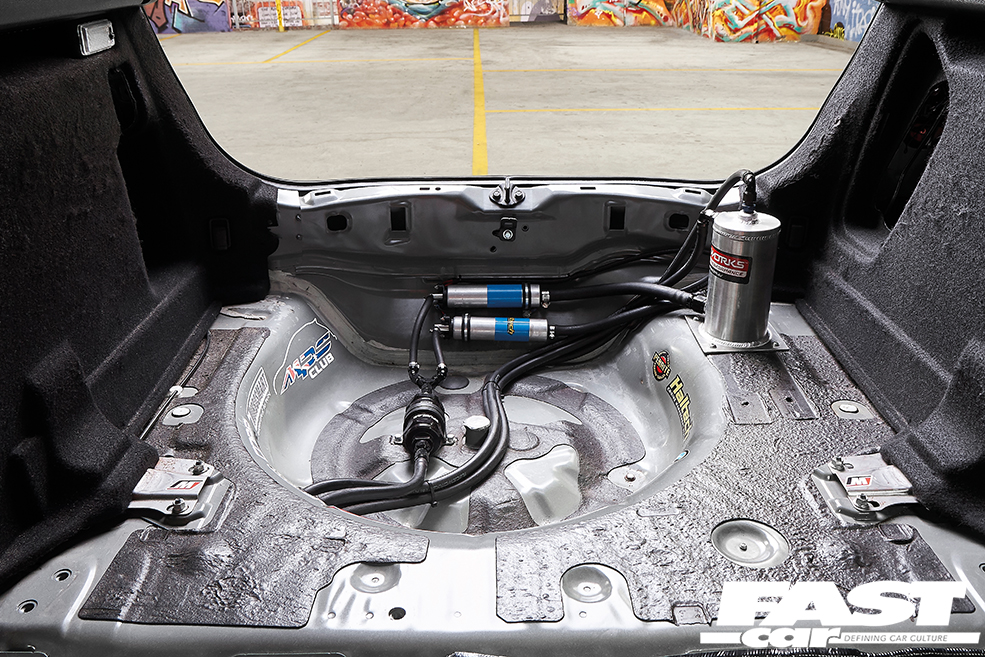
With the car finally complete and wrapped in Hexis Matte Anthracite Grey, Alex drove it from Melbourne to Queensland’s Sunshine Coast a few weeks later where he would set his record time.
The beautifully-finished carbon pieces are responsible for a lot of the extra aggression, but the ‘evil eye’ headlight intake, Fifteen52 overfenders, RPF1s and UK-spec aero mirrors round out what is a thoroughly complete build. Even the drag-spec, nose-down rake works well, despite the otherwise street set-up. Inside, it’s very much all-business, the complete lack of seats for anyone but the driver making it feel every bit a track monster. Having said that, Alex’s desire to keep it streetable means the stock dash, wheel, door cards, air-conditioning, airbags and stereo are all still there. So, when he needs to pick up the kids, he just bolts the rear seats back in and away he goes. Unsurprisingly, the kids love being picked up in such a car. “They want to be picked up in it every day, because their friends think they’re cool,” he laughs.
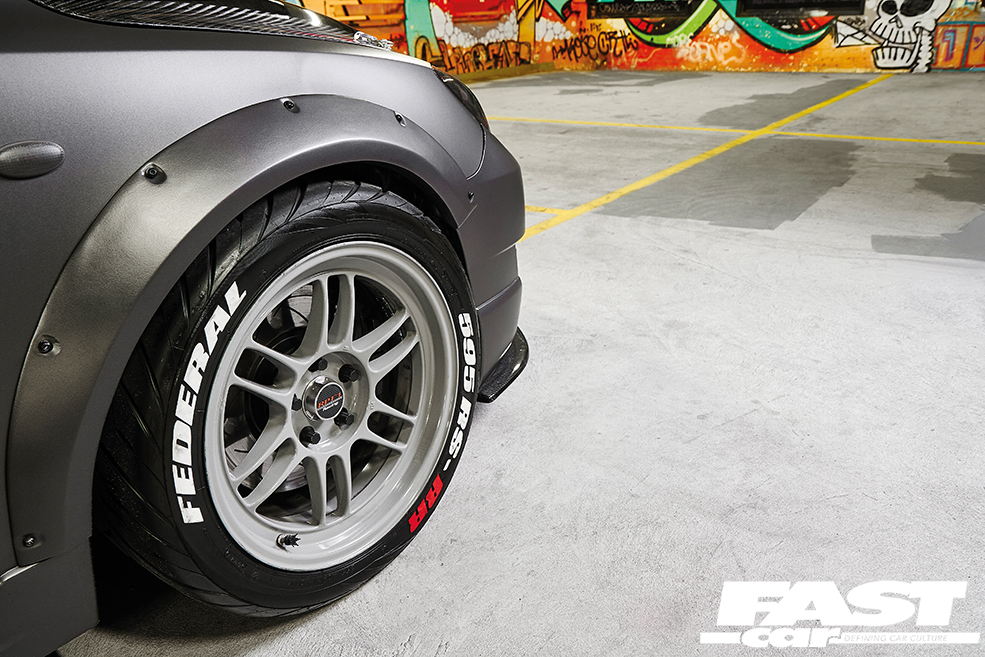
Having set the Aussie record, Alex is currently preparing to try and crack the world Mazda3 record of 9.942, set by Justin Brasil in the USA. He reckons with a few suspension set-up changes, it should be pretty easy, and breaking it with a streetable car will, no doubt, be extra sweet. After that, Alex says he’ll switch to taking on track-prepped GT-Rs on road courses and hillclimbs. “I’ve always wanted a car that’s going to be competitive in every discipline of motorsport – not just one,” and thanks to the prep work already done, all that’s required is a BBK and some settings changes to get the job done.
The end goal is an attempt at World Time Attack Challenge glory. However, while he’s already been approached by a WTAC car builder, he knows it’ll take yet more time to get the car to where he needs it to be. Thankfully, given Alex has no intention of ever selling his Mazda, time isn’t a major issue. Besides, in the interim, he has no problems simply enjoying the car and humiliating those Aussie V8s.
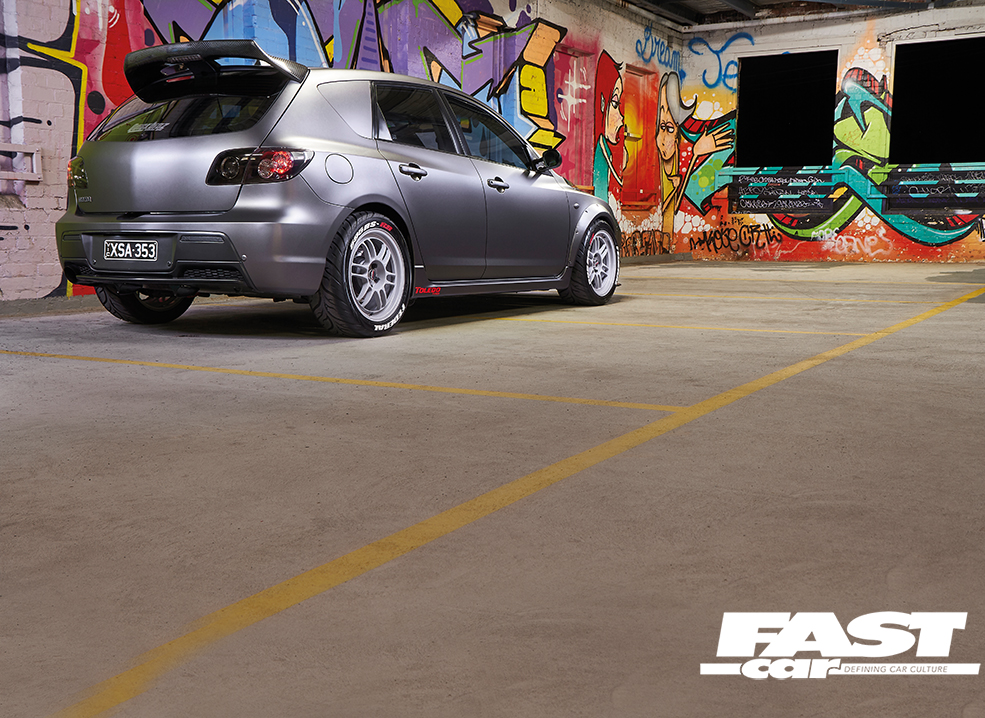
Tech Spec: Modified Mazda3 MPS
Engine:
MZR DISI with Garrett GTX3076R turbo, CNC ported, polished and shaved head, skimmed block, Ferrea +2mm Inconel valves and valve springs, VVT delete, stock cams and cam gears, custom Mine’s RB26-style valve cover baffle kit, Treadstone TR1035 intercooler, Raceworks hoses and fittings, Turbosmart Power Port BOV, Tial 44mm water-cooled wastegate, CPE sand-cast stainless exhaust manifold, custom titanium up and down pipes, DEI titanium turbo blanket and down pipe wrap, custom 3.5-inch mild steel exhaust, Magnaflow 3.5-inch muffler, K&N four-inch pod filter, HTP four-inch intake, Bosch 4 bar MAP sensor, JMF intake manifold, Bosch ID1650 injectors, Denso ITV three-step colder plugs, Wiseco pistons, Carillo rods, Clevite rod bearings, stock crank, balance shaft delete, EGR delete, Cometic Stage 3 head gasket, ARP bolts and studs, custom Freak Fabrications catch tanks, James Barone Racing/TRZ Dogbone engine mounts, twin E85 360lph Pierburg fuel pumps, Fuelab secondary port injection fuel rail, Fuelab fuel lines and pressure regulator, custom Freak Fabrications swirl pot and Haltech Elite 1500 ECU, Clutchmasters 725 twin-plate clutch and cro-moly flywheel, stock LSD and axles.
Chassis:
9.5×17 +35 (f) and 9×17 +35 (r) Enkei RPF1 wheels with 265/40 (f) and 245/40 Federal RS-RR tyres (street). Mickey Thompson 28×10 L8 slicks (f) (drag), BC BR coilovers, customised Hotchkis swaybars (f&r), customised Hotchkis rear swaybar end links, Moog front swaybar end links, custom front camber arms, Megan Racing rear camber arms, Nolathane bushings, AutoExe front and rear lower control arm bars, Eibach 20mm billet spacers and ARP wheel studs, stock calipers with DBA T3 slotted rotors (f&r), Hawk pads (f&r) and Agip fluid.
Exterior:
Horsch Industries custom carbon bonnet, splitter and rear wing, Mazdaspeed3 UK aero mirrors, Fifteen52 front overfenders, Freak Fabrications custom six-inch alloy headlight intake and SevenXCreations Hexis Matte Anthracite Grey wrap.
Interior:
Bride Zieg III race seat, Sabelt four-point harness, stock steering wheel, Sparco shift knob, TWM short shift kit and shift lever, Haltech IQ3 Racepak and front passenger and rear seat removal.
Thanks:
Thanks to my sponsors (Quickbitz, Australian Tank Manufacturers, Kings Krust Pizza Bar, Horsch Design, SevenXcreations, JD Autoworx, Ramco Trailer Co, Toledo Tyre Care, Bolts Galore, Motorsport Connections, Eric Poh Detailing), as well as Caloundra Suspension, Lux Racing, Horsepower Factory, Orger Engines, Freak Fabrication and Edge Autosport for all their invaluable work during and after the build. Special thanks to my wife Camelia and my kids Mirjana and Zoran for all their support.
Feature taken from Banzai magazine. Words and photos: Chris Nicholls.

